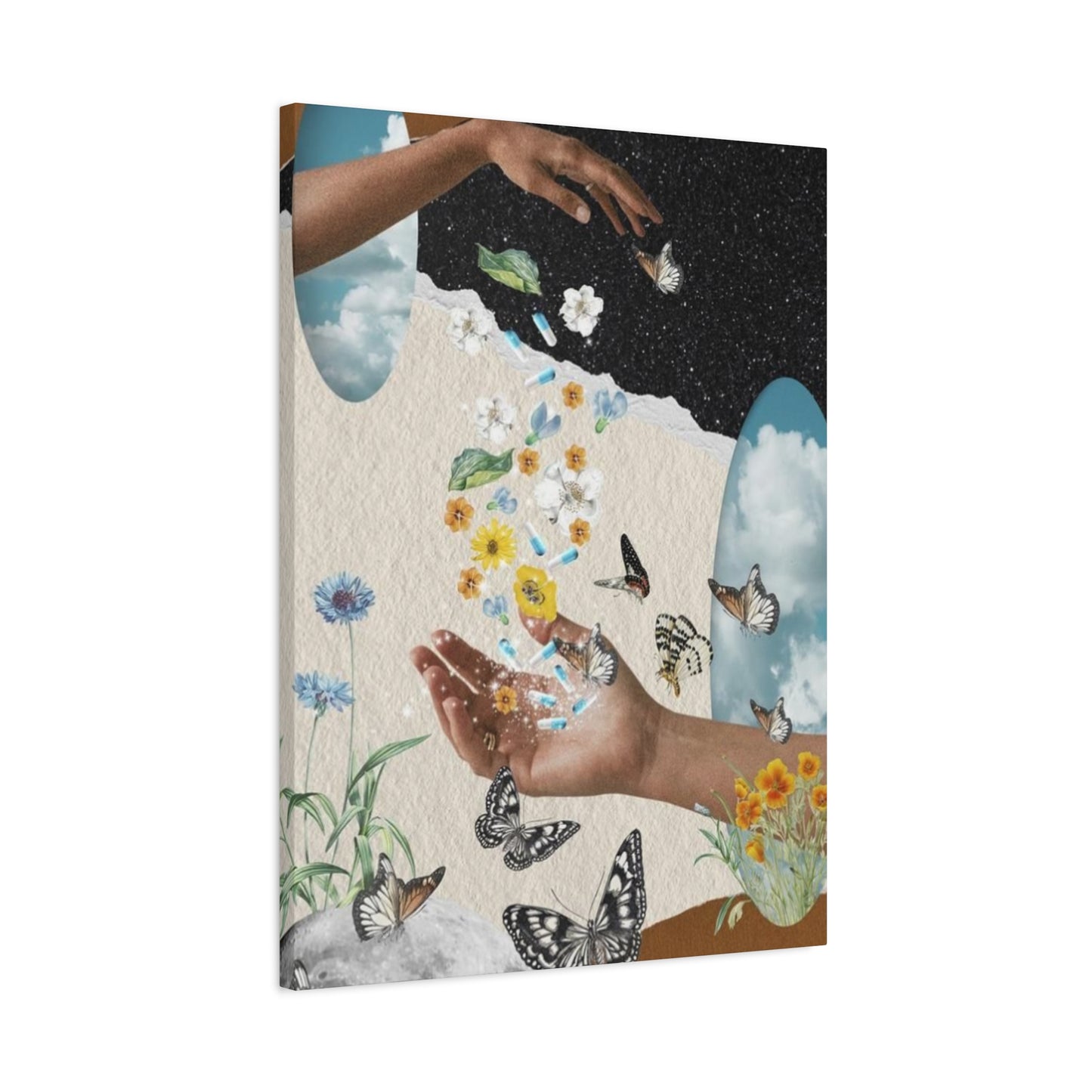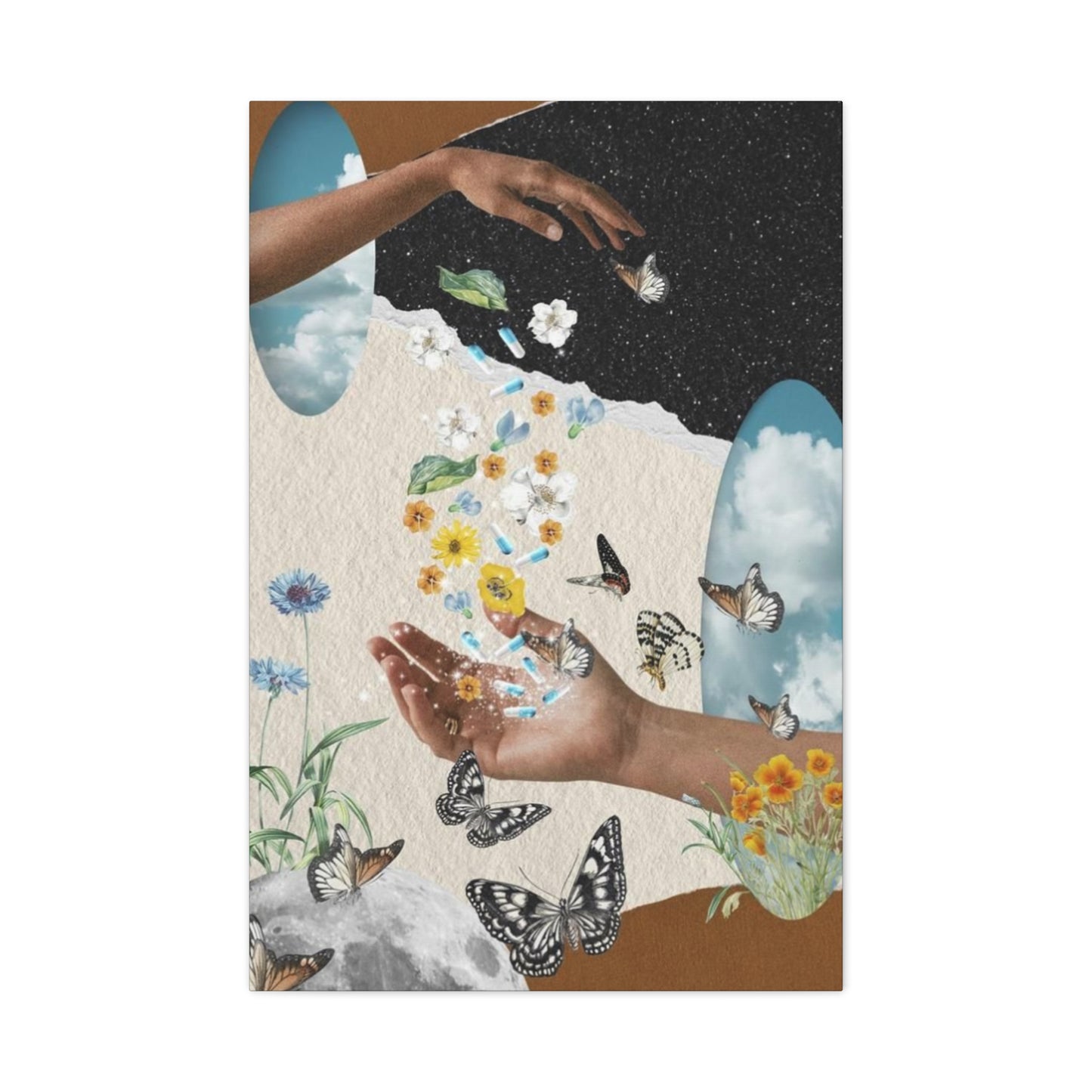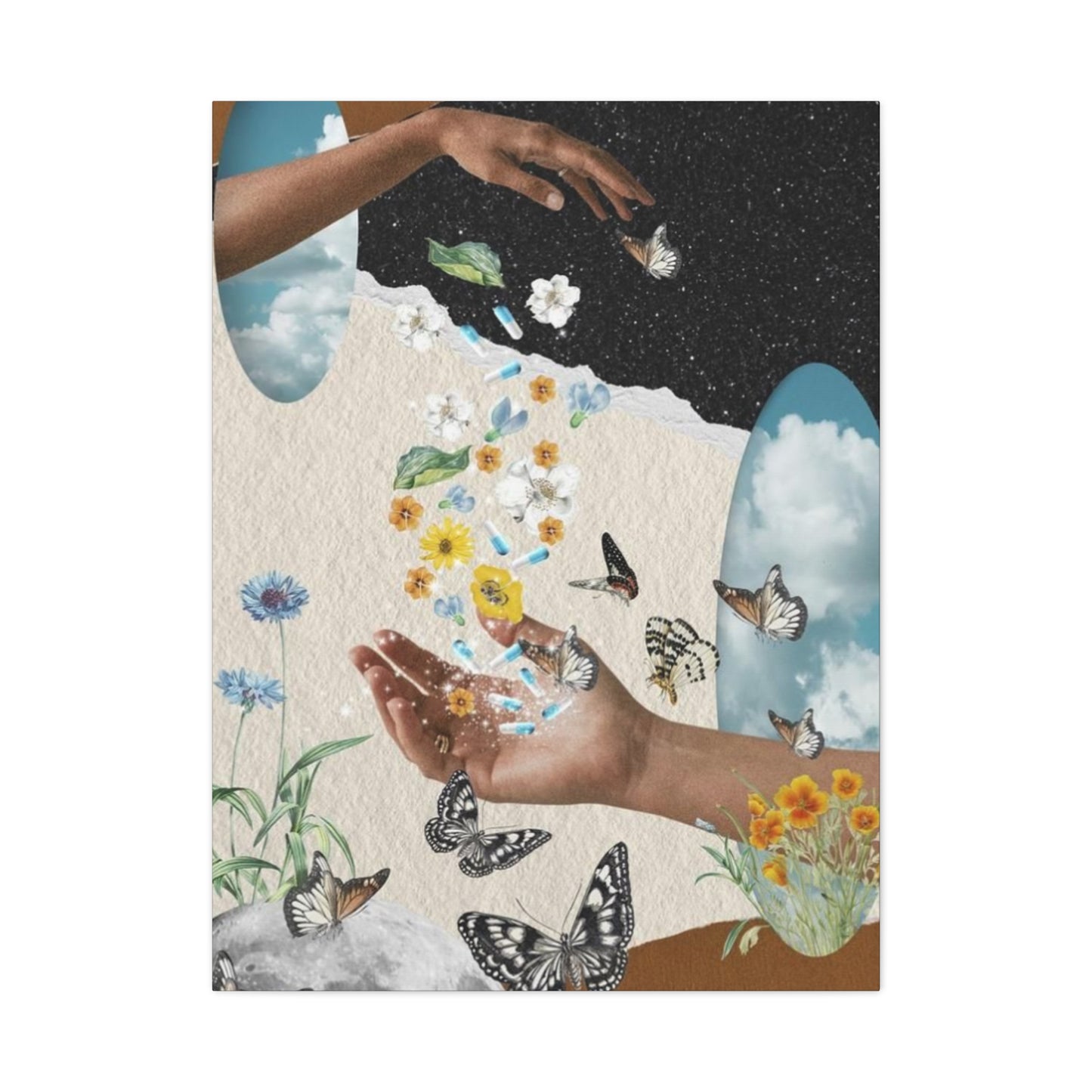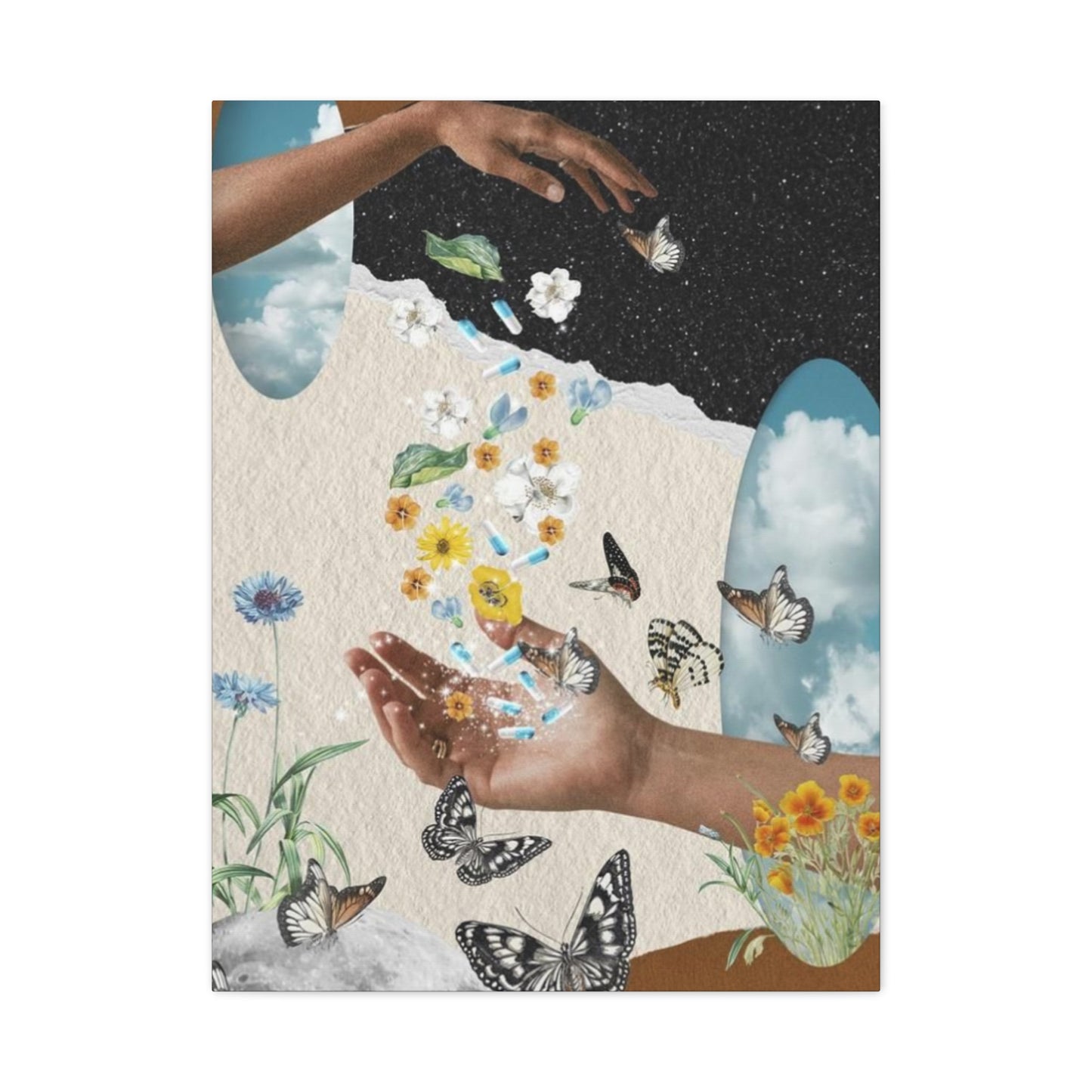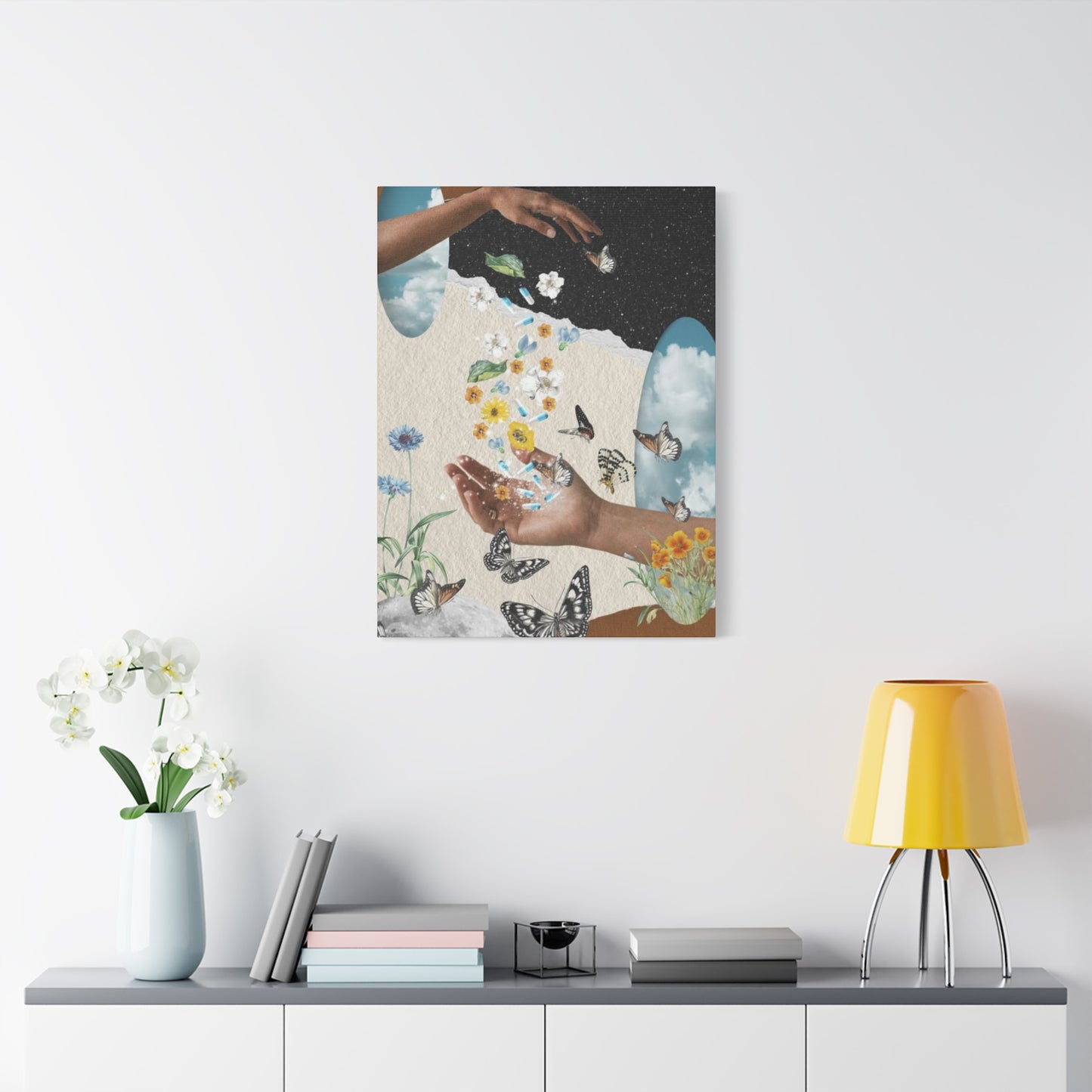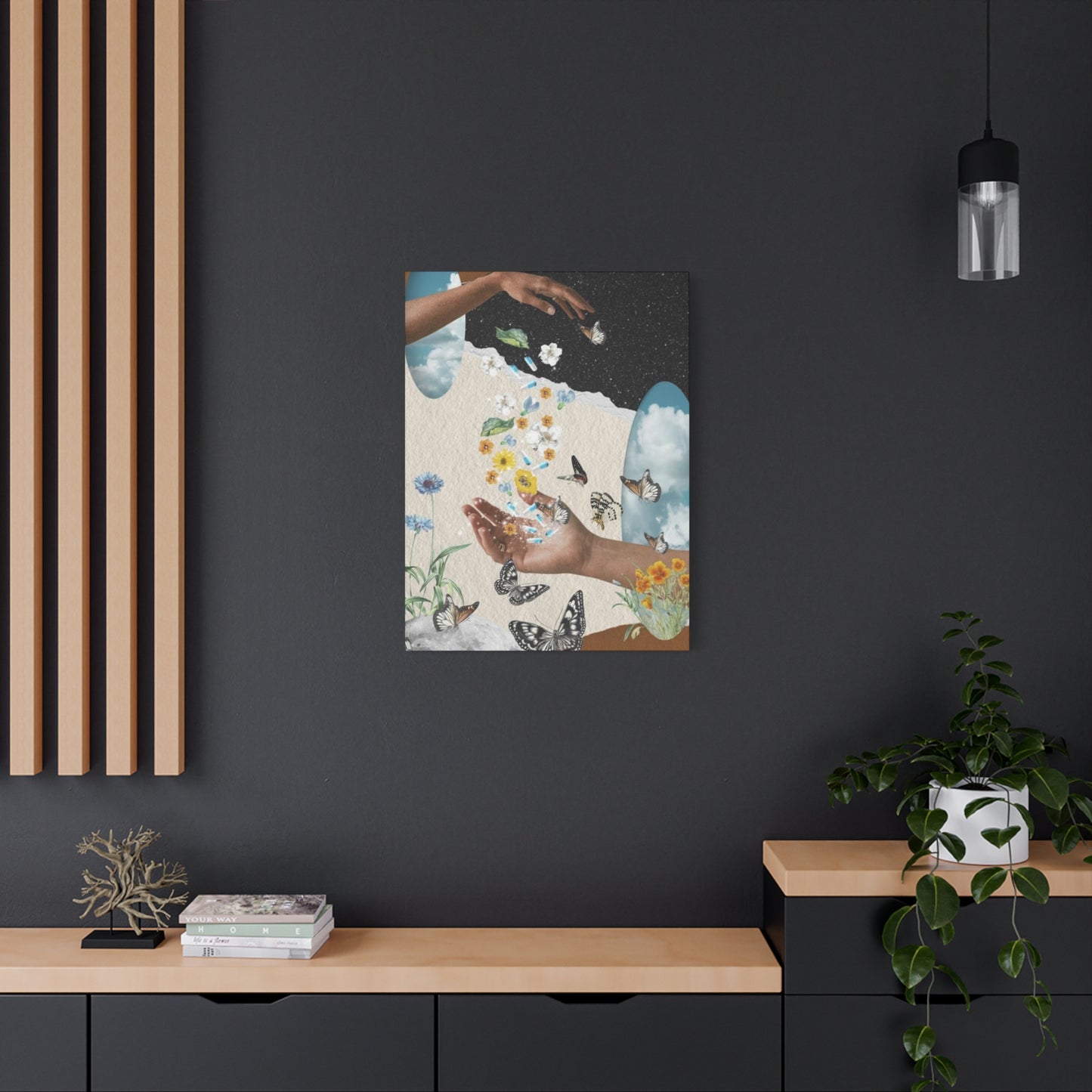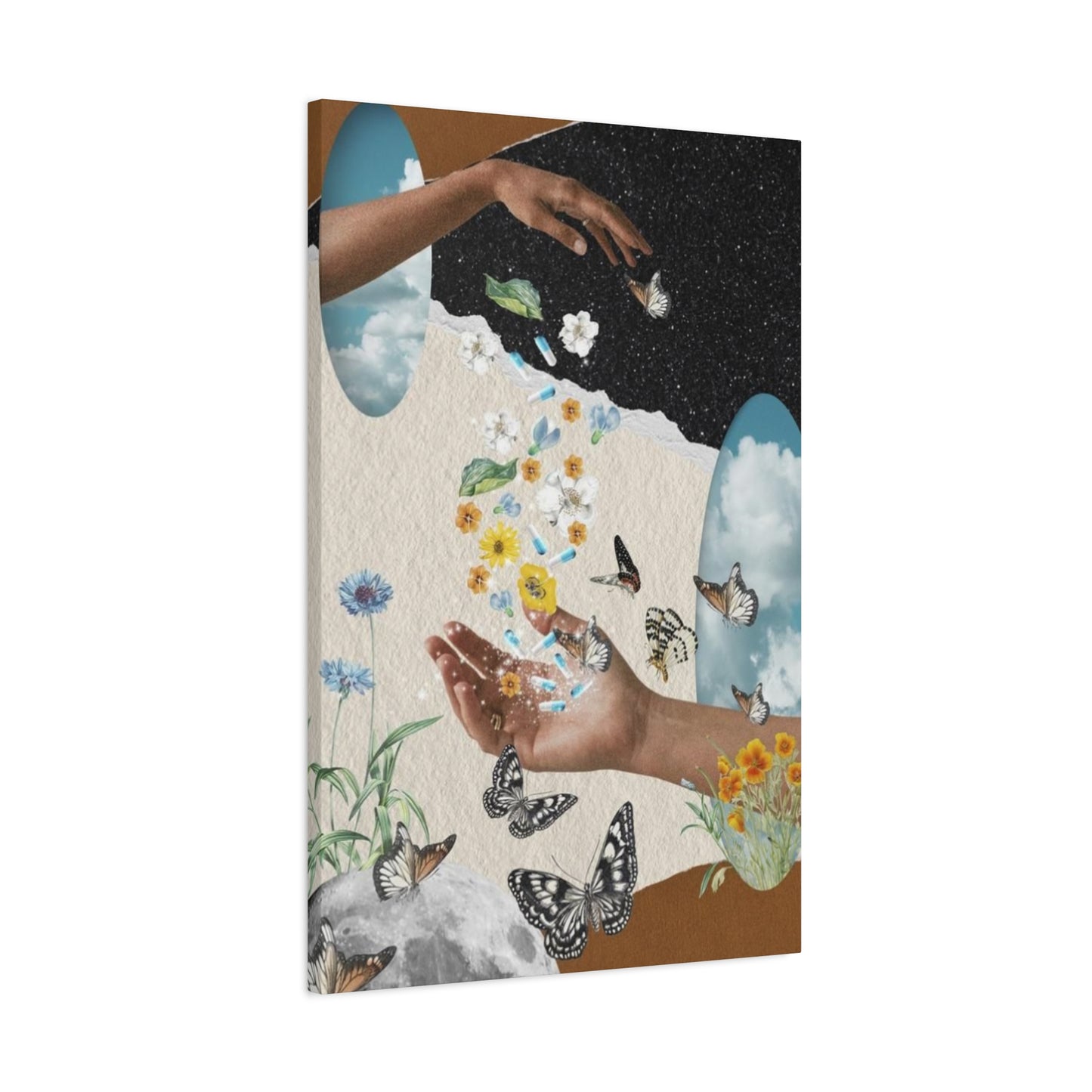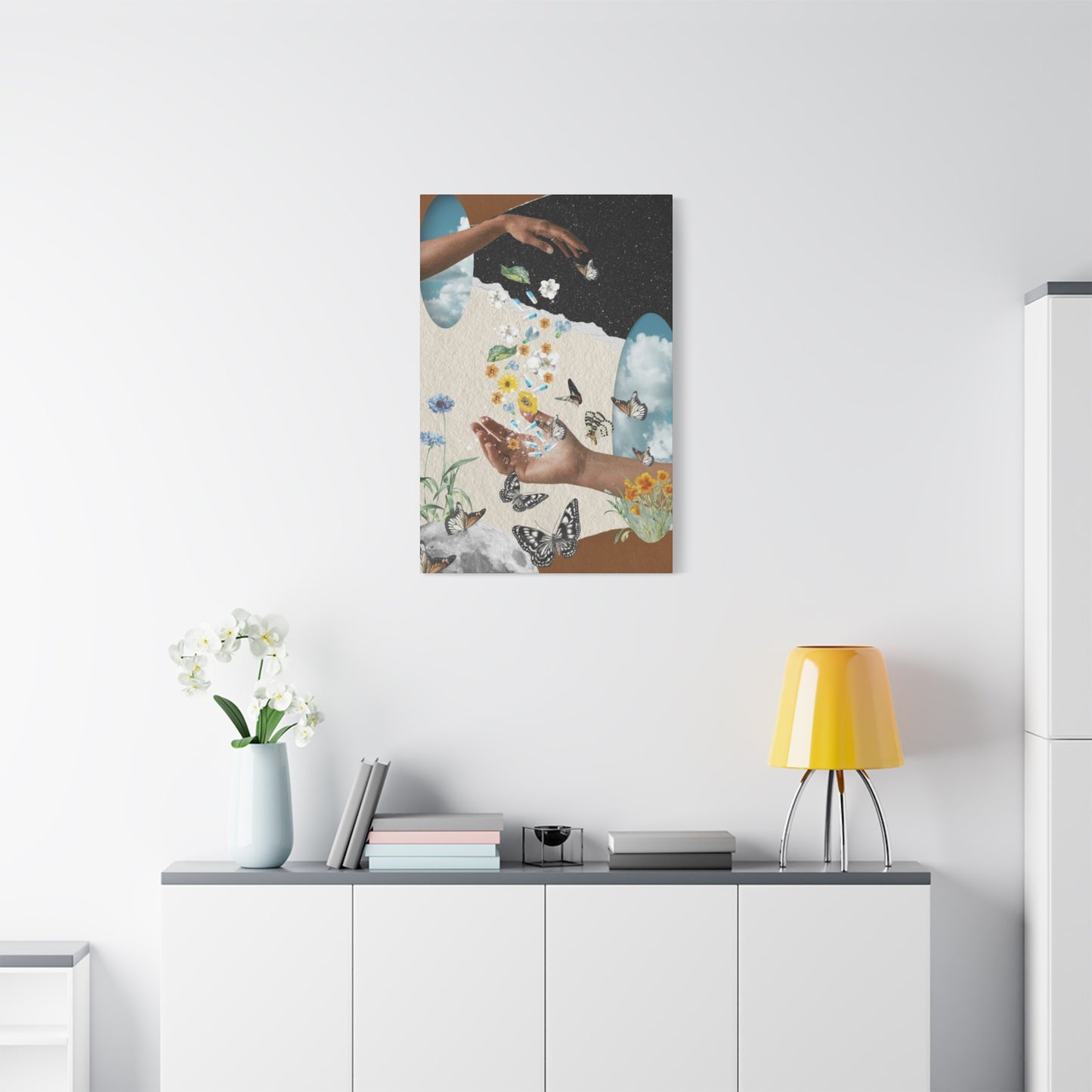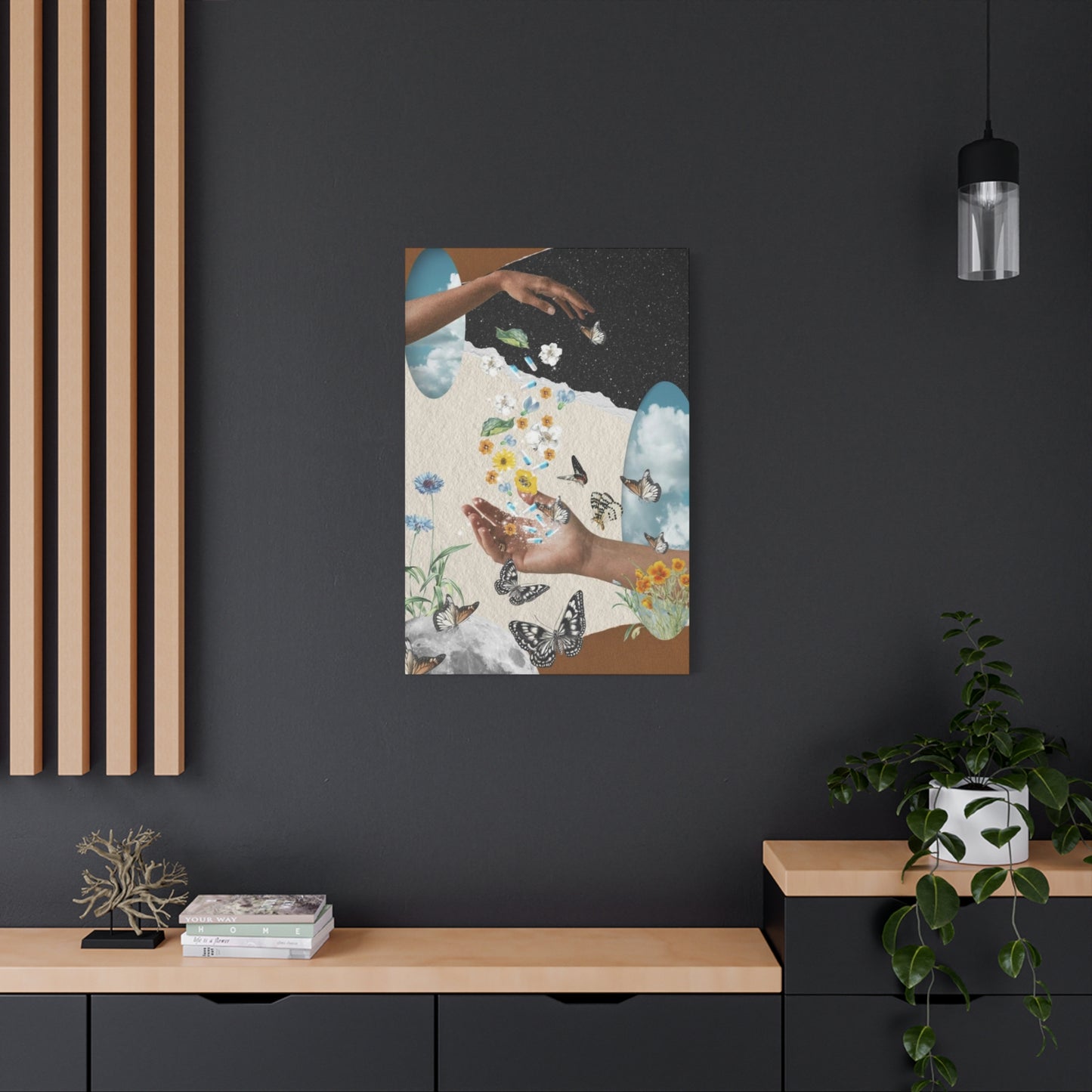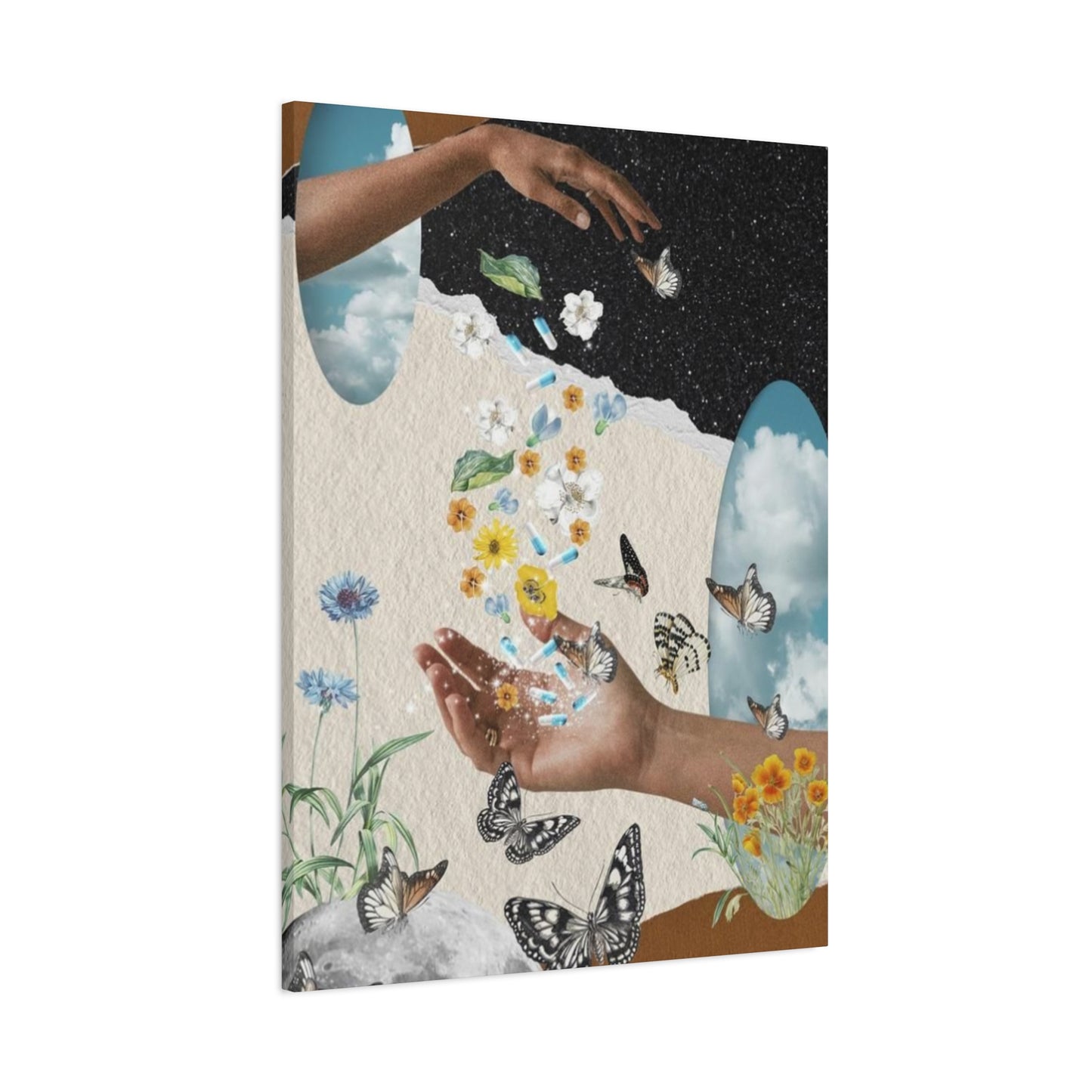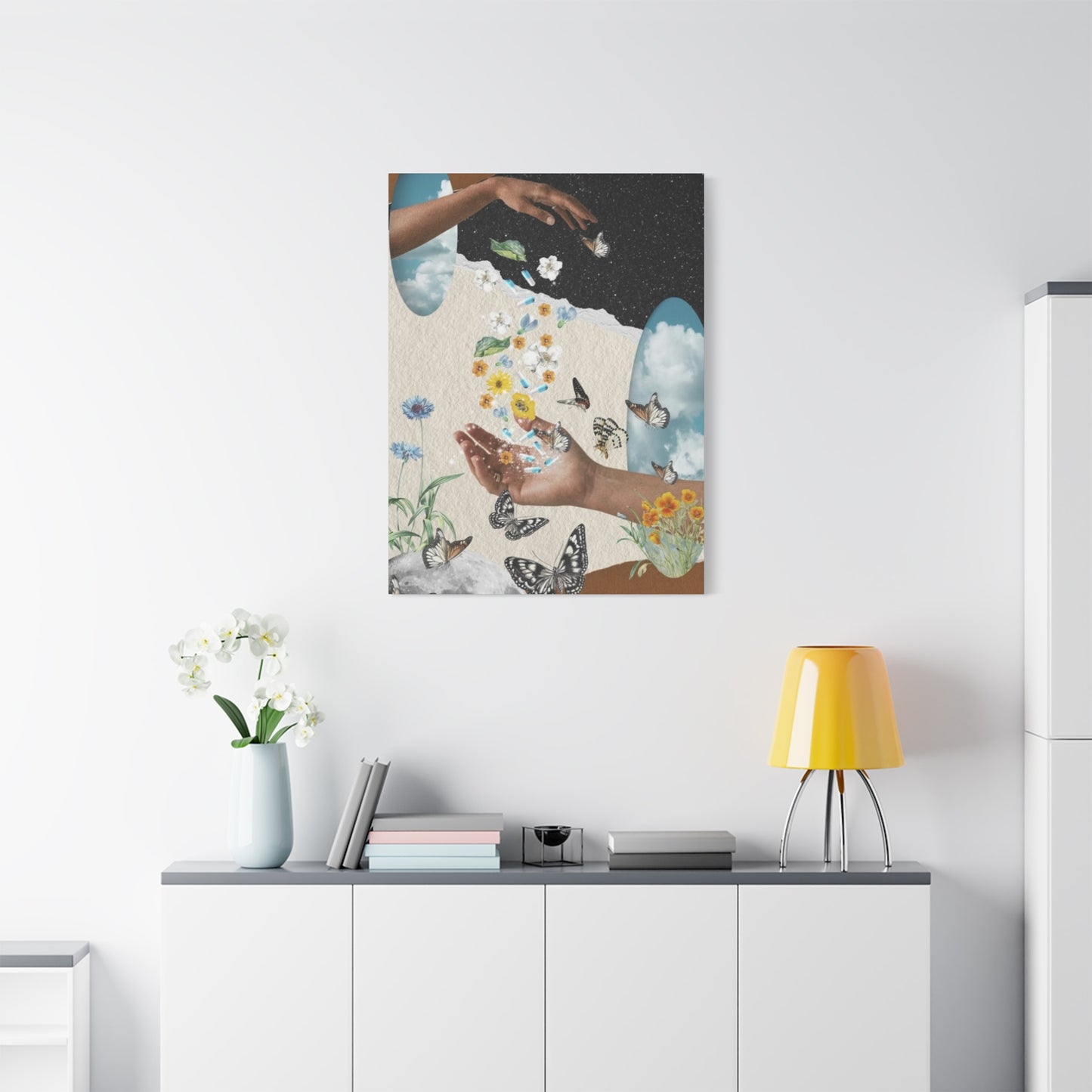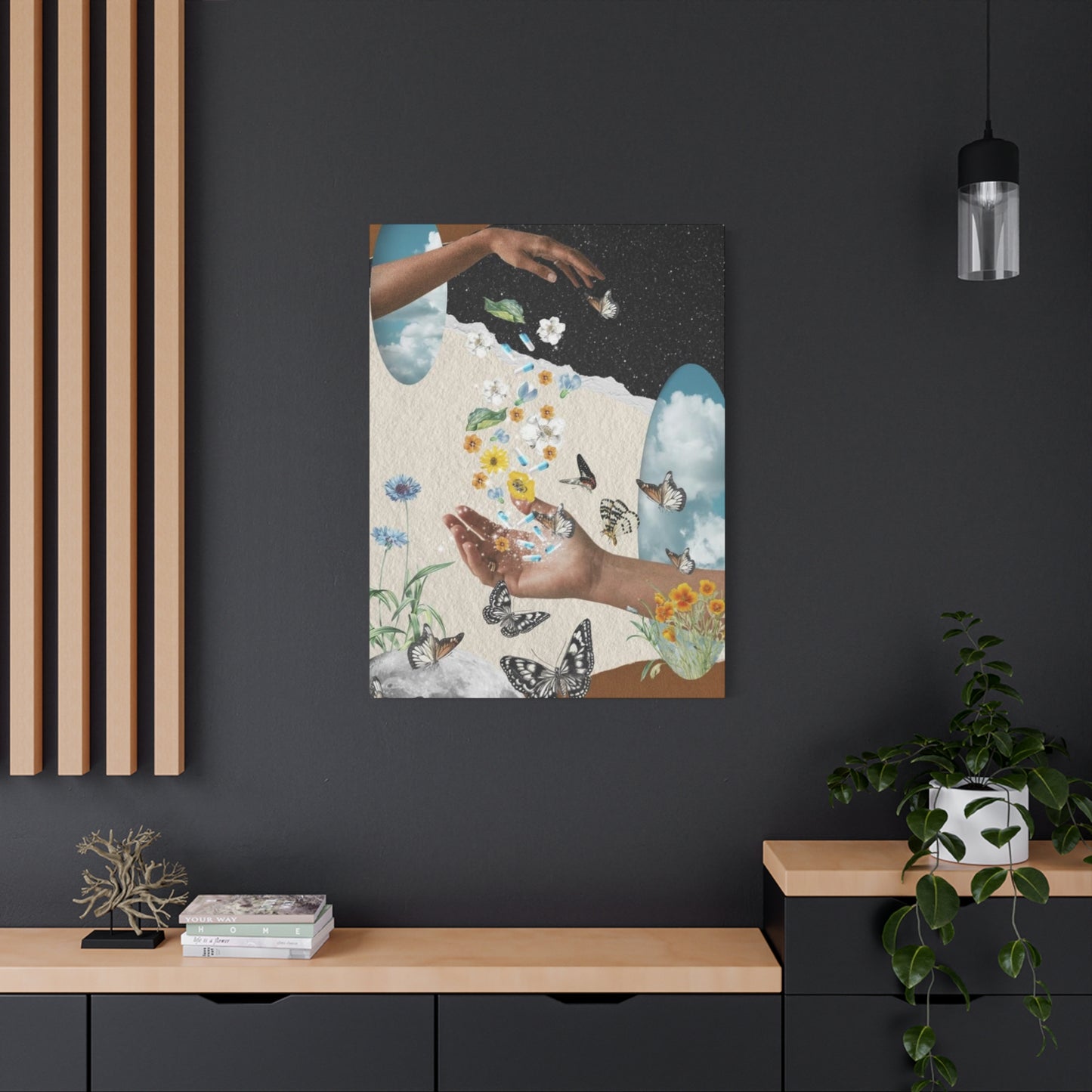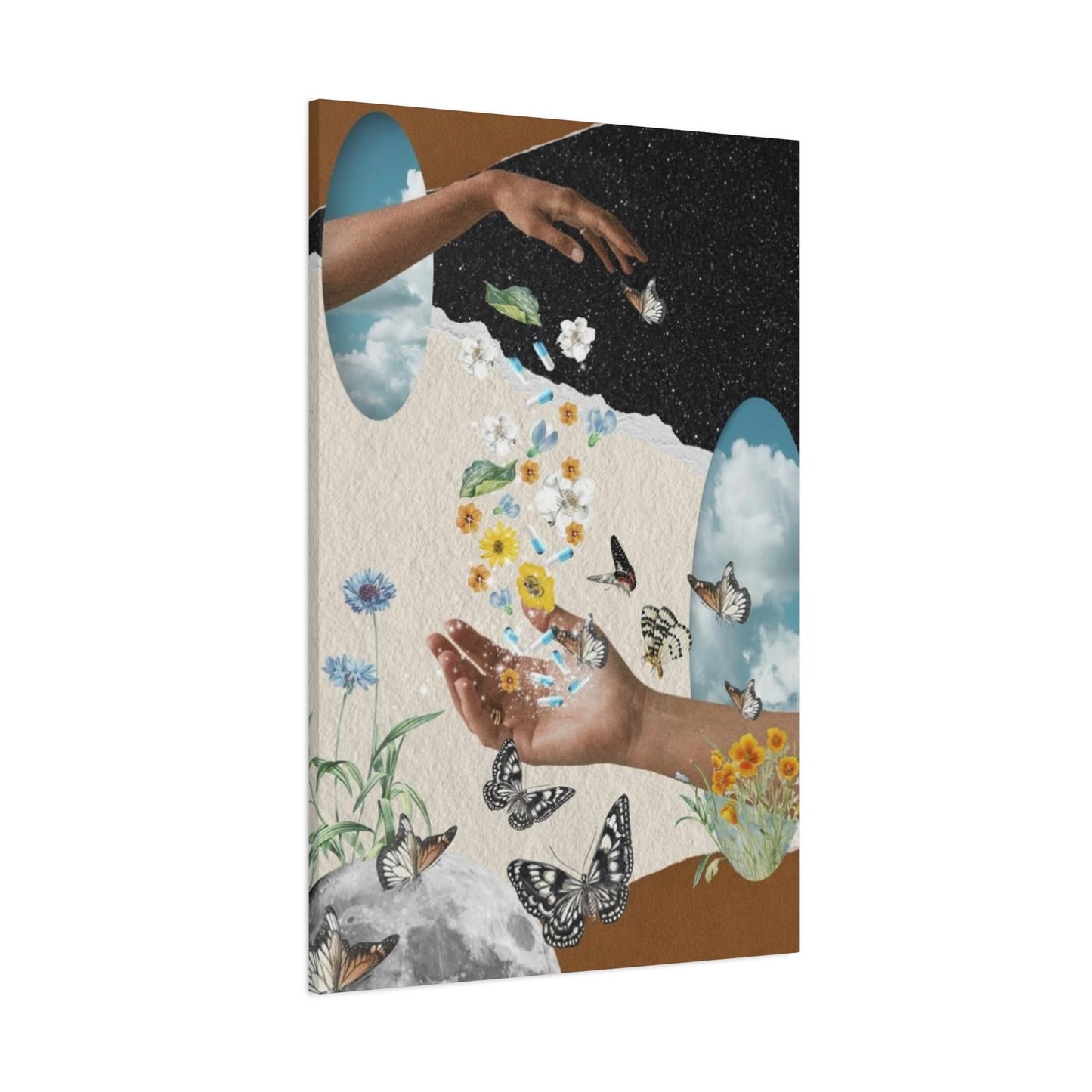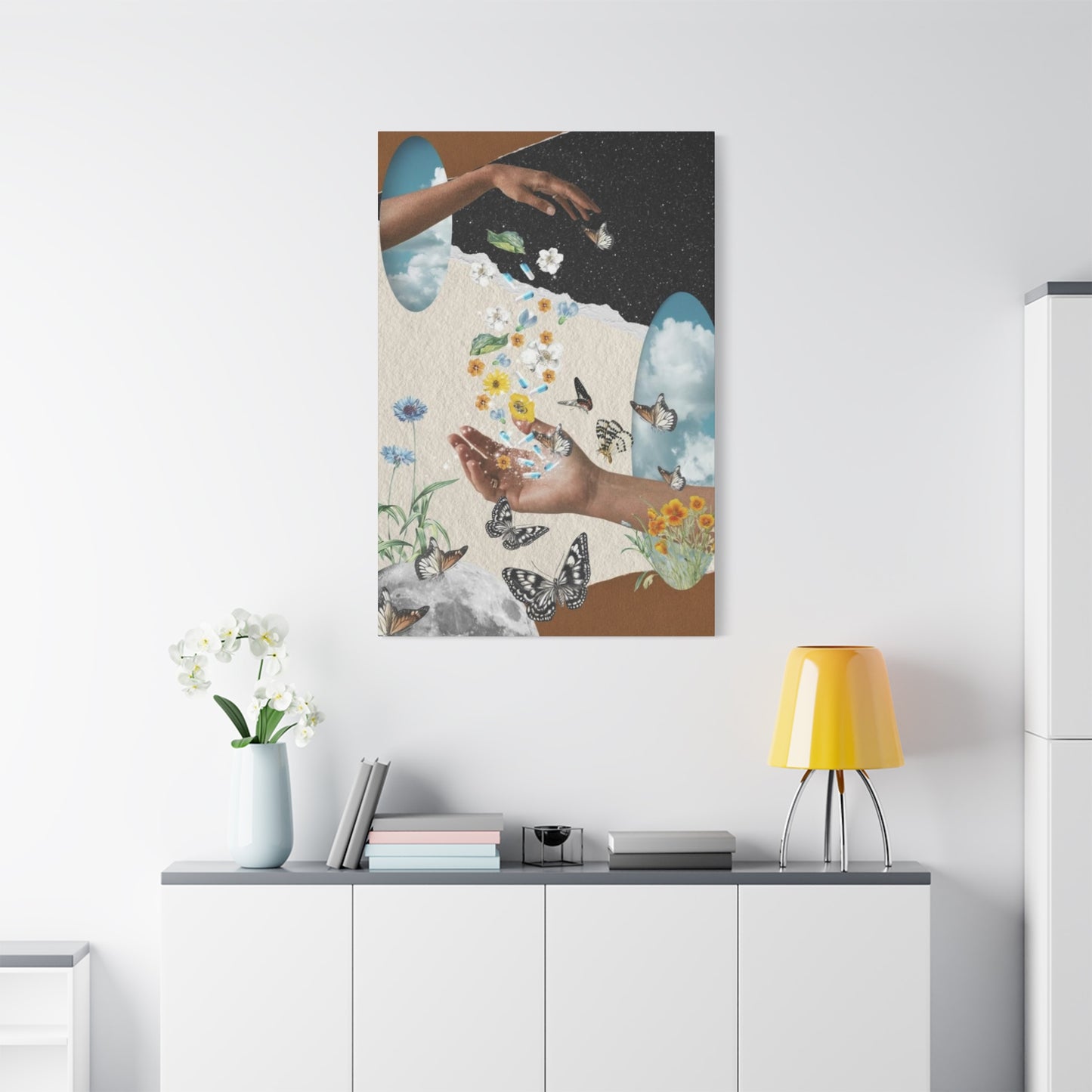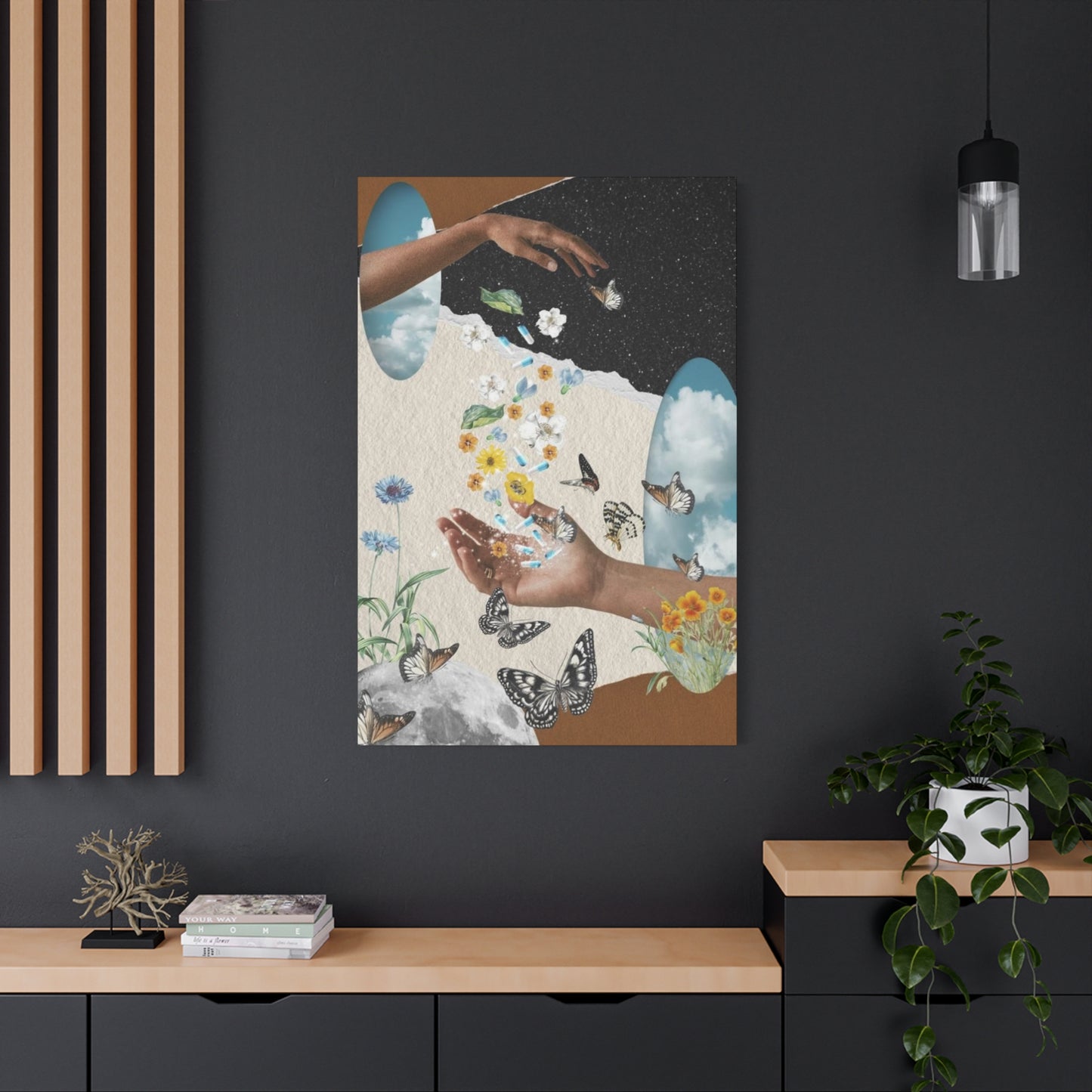Butterfly Abstract Mixed Media Wall Art: Elevating Interior Spaces Through Creative Expression
The world of interior design has witnessed a remarkable evolution in recent years, with butterfly abstract mixed media wall art emerging as a captivating trend that seamlessly blends artistic expression with sophisticated home decor. This fascinating art form combines the delicate beauty of butterfly imagery with contemporary abstract techniques, creating stunning visual experiences that transform ordinary spaces into extraordinary environments. The integration of mixed media elements adds depth, texture, and dimensional quality that traditional paintings simply cannot achieve, making these artworks conversation pieces that captivate viewers and enhance the overall aesthetic appeal of any interior space.
Contemporary artists have embraced butterfly motifs not merely as decorative elements but as powerful symbols of transformation, renewal, and the ephemeral nature of beauty. When combined with abstract techniques and mixed media applications, these artworks transcend traditional boundaries, offering viewers multiple layers of interpretation and emotional connection. The versatility of butterfly abstract mixed media wall art allows it to complement various interior design styles, from minimalist modern spaces to eclectic bohemian environments, making it an invaluable addition to any art collector's repertoire or homeowner's decorative arsenal.
Butterfly Motifs in Contemporary Art
The resurgence of butterfly motifs in contemporary art reflects a broader cultural fascination with natural elements and their symbolic significance. Modern artists have reimagined these delicate creatures through innovative lens, moving beyond literal representations to explore abstract interpretations that capture the essence of transformation and metamorphosis. Contemporary butterfly art often incorporates bold color palettes, experimental techniques, and unconventional materials that challenge traditional artistic boundaries while maintaining the inherent grace and beauty associated with these winged creatures.
Artists working with butterfly motifs today often draw inspiration from scientific illustrations, botanical studies, and digital imagery, creating hybrid works that blend realism with abstraction. The contemporary approach to butterfly art frequently emphasizes the geometric patterns found in butterfly wings, translating these natural designs into modern artistic language through bold strokes, vibrant colors, and innovative compositional arrangements. This evolution has resulted in artworks that speak to both nature enthusiasts and modern art collectors, bridging the gap between traditional naturalistic art and contemporary abstract expression.
The psychological impact of butterfly imagery in contemporary art cannot be understated. These creatures represent transformation, rebirth, and the cyclical nature of life, themes that resonate deeply with modern audiences seeking meaning and connection in an increasingly digital world. Contemporary artists leverage these symbolic associations, creating works that invite contemplation and emotional engagement while simultaneously serving as striking decorative elements that enhance interior spaces with their visual appeal and conceptual depth.
Bright Accent Walls with Butterfly Abstract Prints
Creating dynamic accent walls with bright butterfly abstract prints has become a popular interior design strategy that instantly transforms spaces from mundane to magnificent. The strategic placement of vibrant butterfly artwork on accent walls serves as a focal point that draws attention and creates visual interest without overwhelming the entire room. These installations work particularly well in living areas, bedrooms, and creative spaces where the goal is to inject personality and energy into the environment while maintaining overall design harmony.
The selection process for accent wall butterfly prints requires careful consideration of color harmony, scale, and thematic consistency. Bright, saturated colors work exceptionally well against neutral backgrounds, creating striking contrasts that make the artwork pop while ensuring the space remains visually balanced. The size and arrangement of prints can dramatically impact the overall effect, with larger single pieces creating bold statements and collections of smaller works offering more dynamic, gallery-like presentations that encourage closer examination and appreciation.
Lighting plays a crucial role in maximizing the impact of bright butterfly abstract prints on accent walls. Proper illumination enhances color vibrancy and brings out textural details that might otherwise go unnoticed. Track lighting, picture lights, or strategically placed spotlights can create dramatic effects that change throughout the day, making the artwork appear to come alive as natural and artificial light sources shift and interact with the colorful surfaces.
The psychological benefits of incorporating bright butterfly abstract prints into interior spaces extend beyond mere aesthetic appeal. These vibrant artworks can positively influence mood, energy levels, and creativity, making them particularly valuable in work spaces, creative studios, and areas dedicated to relaxation and rejuvenation. The combination of natural butterfly motifs with bright, energizing colors creates an environment that feels both invigorating and calming, striking a perfect balance for modern living.
Mixed Media Techniques for Vibrant Wall Art
The realm of mixed media techniques offers artists unlimited possibilities for creating vibrant butterfly wall art that pushes creative boundaries and challenges conventional artistic approaches. These techniques combine traditional painting methods with unconventional materials such as fabric, paper, metal elements, found objects, and digital components to create multi-dimensional artworks that engage viewers on multiple sensory levels. The layering of different materials and textures creates depth and visual complexity that cannot be achieved through single-medium approaches.
Acrylic paints serve as an excellent foundation for mixed media butterfly art, providing vibrant base colors that interact beautifully with other materials. Artists often begin with bold acrylic backgrounds before incorporating collage elements, textured papers, metallic accents, and three-dimensional components that add visual weight and tactile interest to the composition. The fast-drying nature of acrylics allows for rapid layering and experimentation, enabling artists to build complex compositions that maintain color clarity and vibrancy throughout the creative process.
Paper collage techniques add remarkable versatility to butterfly mixed media artworks, allowing artists to incorporate patterns, textures, and colors from various sources including magazines, handmade papers, sheet music, and vintage documents. These elements can be strategically placed to create butterfly wings, background textures, or abstract compositional elements that enhance the overall visual narrative. The juxtaposition of different paper types and printing techniques creates visual tension and interest that draws viewers into detailed examination of the artwork.
Textile elements bring unique tactile qualities to mixed media butterfly art, introducing softness, texture variation, and dimensional possibilities that enrich the viewing experience. Fabric pieces, thread work, and fiber elements can simulate the delicate texture of butterfly wings while adding physical depth that creates shadows and highlights as viewing angles change. These organic materials connect viewers to the natural world that butterflies represent, creating emotional resonance that extends beyond purely visual appreciation.
Incorporating Abstract Butterflies in Gallery Walls
The art of creating compelling gallery walls with abstract butterfly artworks requires careful consideration of visual flow, color harmony, and compositional balance to achieve professional-looking installations that enhance rather than overwhelm interior spaces. Gallery walls offer unique opportunities to showcase multiple butterfly artworks while creating cohesive visual narratives that tell stories and evoke emotions through thoughtful curation and strategic placement. The key to successful gallery wall design lies in understanding how individual pieces interact with each other and contribute to the overall aesthetic impact.
Scale variation plays a crucial role in creating dynamic gallery wall compositions with abstract butterfly art. Mixing larger statement pieces with smaller complementary works creates visual rhythm and prevents monotony while maintaining thematic consistency. The interplay between different sizes creates natural focal points and guides viewer attention throughout the composition, ensuring that each artwork receives appropriate consideration while contributing to the collective impact of the entire installation.
Color coordination strategies for butterfly gallery walls must balance unity with variety to create installations that feel intentional rather than random. Successful approaches often involve selecting a dominant color palette that appears throughout the collection while allowing for accent colors that add interest and prevent visual stagnation. The repetition of certain hues creates continuity, while strategic color variations maintain viewer engagement and prevent the composition from feeling too predictable or controlled.
Spacing and arrangement considerations significantly impact the effectiveness of butterfly gallery walls. Professional installations typically maintain consistent spacing between frames, usually ranging from two to three inches, creating clean sight lines that allow each artwork to breathe while maintaining visual connection to neighboring pieces. The overall shape of the gallery wall arrangement should complement the architectural features of the space, whether following wall proportions, furniture lines, or other design elements present in the room.
The Emotional Power of Color in Butterfly Art
Color psychology plays a fundamental role in how butterfly art affects viewers emotionally and psychologically, with different color combinations evoking specific responses and creating distinct atmospheric qualities within interior spaces. The strategic use of color in abstract butterfly artworks can influence mood, energy levels, and emotional well-being, making color selection a critical consideration for both artists and collectors seeking to achieve specific environmental goals through their art choices.
Warm color palettes featuring reds, oranges, and yellows in butterfly art create energizing, welcoming atmospheres that promote social interaction and creative thinking. These colors evoke feelings of warmth, comfort, and vitality, making them particularly effective in living areas, dining spaces, and creative studios where the goal is to encourage activity and engagement. The intensity and saturation of warm colors can be adjusted to achieve different effects, from subtle background enhancement to bold statement-making focal points.
Cool color schemes dominated by blues, greens, and purples tend to create calming, contemplative environments that promote relaxation and introspection. Butterfly artworks featuring cool palettes work exceptionally well in bedrooms, meditation spaces, and areas dedicated to quiet activities such as reading or studying. These colors can help reduce stress levels and create peaceful atmospheres that support rest and rejuvenation, making them valuable tools for creating restorative interior environments.
The psychological impact of color combinations in butterfly art extends beyond individual color effects to include the emotional resonance created by color relationships and contrasts. Complementary color schemes create visual excitement and energy, while analogous palettes promote harmony and tranquility. Understanding these relationships allows for strategic color selection that supports specific lifestyle goals and enhances the overall quality of interior environments through thoughtful artistic integration.
Minimalist Rooms Enhanced with Bold Butterfly Prints
The integration of bold butterfly abstract prints into minimalist interior designs creates striking contrasts that demonstrate how carefully selected artwork can serve as powerful focal points without compromising the clean, uncluttered aesthetic that defines minimalist spaces. This approach requires sophisticated understanding of visual balance and restraint, ensuring that the dramatic impact of butterfly art enhances rather than overwhelms the purposeful simplicity that characterizes minimalist design philosophy.
The principle of selective emphasis becomes crucial when incorporating butterfly art into minimalist environments. Rather than filling walls with multiple artworks, minimalist spaces benefit from single, impactful pieces that command attention and create emotional resonance through their presence alone. Large-scale butterfly abstract prints work particularly well in this context, providing sufficient visual weight to anchor spaces while maintaining the clean lines and open feeling that minimalist design celebrates.
Color selection for butterfly art in minimalist spaces often follows restrained palettes that complement rather than compete with the neutral backgrounds typical of these environments. Black and white butterfly abstracts create sophisticated statements that align with minimalist sensibilities, while selective use of single accent colors can provide controlled pops of interest that energize spaces without creating visual chaos. The key lies in maintaining color discipline while allowing the artwork to provide necessary emotional warmth and personality.
The positioning and framing of butterfly prints in minimalist spaces requires particular attention to proportion and placement. Artworks should relate proportionally to furniture and architectural elements, creating visual harmony that supports the overall design scheme. Clean, simple framing solutions that emphasize the artwork rather than drawing attention to themselves help maintain the uncluttered aesthetic while providing appropriate presentation for valuable art pieces.
Abstract Butterfly Art for Office Spaces
The incorporation of abstract butterfly art into office environments represents a growing trend that recognizes the positive impact of nature-inspired artwork on workplace productivity, creativity, and employee well-being. These artworks serve multiple functions in professional settings, providing visual interest that breaks up monotonous office landscapes while introducing elements of natural beauty that can reduce stress and promote mental clarity throughout the workday.
Color psychology becomes particularly important in office applications of butterfly art, as different colors can influence work performance and emotional states in professional environments. Blue butterfly abstracts promote focus and concentration, making them excellent choices for areas dedicated to detailed work or analytical thinking. Green tones create balance and reduce eye strain, particularly valuable in spaces with extensive computer use or prolonged visual tasks.
The scale and placement of butterfly art in office spaces must consider both aesthetic impact and practical functionality. Artworks should be positioned to provide visual relief from work tasks without creating distractions that impede productivity. Common wall areas, break rooms, and conference spaces offer ideal locations for butterfly art installations that can be appreciated during breaks or transitions between work activities, providing mental refreshment that supports overall workplace satisfaction.
Professional environments benefit from butterfly art that maintains appropriate levels of abstraction and sophistication, avoiding overly literal or decorative approaches that might appear unprofessional. Abstract interpretations allow for personal interpretation while maintaining the universal appeal necessary for diverse workplace populations. The transformational symbolism associated with butterflies can serve as positive metaphors for business growth, innovation, and personal development within professional contexts.
Blending Acrylics and Collage in Mixed Media Art
The combination of acrylic paints with collage elements creates dynamic mixed media butterfly artworks that exploit the unique properties of both mediums to achieve effects impossible through single-medium approaches. Acrylics provide vibrant, permanent color foundations that interact beautifully with paper, fabric, and other collage materials, creating layered compositions that reward detailed examination while maintaining strong overall visual impact from viewing distances.
Technical considerations for successful acrylic and collage combinations include understanding adhesion properties, drying times, and material compatibility to ensure artwork longevity and visual stability. Quality acrylic mediums can serve dual purposes as paint extenders and adhesives for collage elements, creating seamless integration between painted and applied components. The timing of material application becomes crucial, as working with appropriate wetness levels allows for better material bonding and color blending between different components.
The selection of collage materials for butterfly art opens endless creative possibilities, from traditional paper sources to unconventional materials that add unexpected textural and visual interest. Vintage sheet music, botanical illustrations, fabric scraps, metallic papers, and handmade papers each contribute unique qualities that can enhance butterfly wing patterns, create background textures, or serve as abstract compositional elements that support the overall artistic narrative.
Layering strategies in acrylic and collage butterfly art require careful planning to achieve desired depth and complexity while maintaining visual clarity and compositional strength. Building compositions from background to foreground allows for strategic placement of collage elements that interact with painted passages to create convincing dimensional effects. The interplay between transparent and opaque passages adds visual interest while allowing underlying layers to contribute to the final appearance.
Butterfly Abstracts as Conversation Starters
Abstract butterfly artworks possess unique qualities that naturally encourage conversation and social interaction, making them valuable additions to spaces where human connection and communication are priorities. The combination of recognizable butterfly motifs with abstract interpretation provides accessible entry points for art appreciation while offering sufficient complexity to sustain extended discussion and multiple interpretations, creating natural opportunities for meaningful exchanges between viewers.
The conversational appeal of butterfly abstracts stems partly from their ability to evoke personal memories and associations that vary among individuals. These artworks often trigger recollections of childhood experiences, garden encounters, or symbolic interpretations related to transformation and change, providing rich material for personal sharing and connection. The universal familiarity with butterflies combined with abstract artistic interpretation creates comfortable discussion starting points that can evolve into deeper conversations about art, nature, and personal experiences.
Strategic placement of butterfly abstract art in social spaces maximizes their conversation-starting potential. Dining areas, living rooms, and entertainment spaces benefit from artwork positioning that naturally draws attention without overwhelming the space or competing with social activities. The height, lighting, and surrounding context all influence how effectively artworks facilitate conversation and contribute to social atmosphere within interior environments.
The interpretive flexibility of abstract butterfly art allows different viewers to discover personal meanings and connections, creating opportunities for shared discovery and discussion that enhance social experiences. Rather than presenting definitive statements that limit interpretation, these artworks invite exploration and personal response, making them ideal focal points for environments where diverse perspectives and opinions are valued and encouraged.
Choosing the Perfect Frame for Mixed Media Canvases
The selection of appropriate framing solutions for mixed media butterfly artworks requires careful consideration of both protective and aesthetic factors, as these complex artworks often include dimensional elements and material combinations that present unique framing challenges. The frame must provide adequate protection for diverse materials while enhancing rather than competing with the artwork's visual impact and thematic content.
Depth considerations become crucial when framing mixed media butterfly art that incorporates raised elements, collage layers, or dimensional components. Shadow box frames or deep rabbet frames provide necessary clearance for three-dimensional elements while maintaining professional presentation standards. The depth selection must accommodate the highest points of the artwork while providing some breathing room to prevent contact between materials and glazing materials.
Material selection for frames should complement the artistic content while providing appropriate protection for mixed media components. Natural wood frames often harmonize well with butterfly art themes, providing organic connection to the natural world that butterflies represent. Metal frames can provide contemporary sophistication that allows artwork to dominate while maintaining clean, professional presentation. The finish and color of framing materials should enhance rather than compete with the artwork's color palette and overall aesthetic impact.
Glazing decisions for mixed media butterfly art must balance protection with visual clarity and reflection management. Regular glass provides basic protection but may create reflections that interfere with artwork appreciation. Museum-quality glazing reduces reflections and provides UV protection that helps preserve colors and materials over time, making it worthwhile investment for valuable artworks. Anti-reflective coatings allow for better artwork visibility in various lighting conditions while maintaining protective benefits.
How to Care for Mixed Media Wall Art
Proper care and maintenance of mixed media butterfly wall art extends artwork lifespan while preserving visual quality and material integrity for long-term enjoyment and investment protection. These complex artworks require specific attention to environmental factors, cleaning procedures, and handling practices that differ from traditional painting care requirements due to their diverse material compositions and potential dimensional elements.
Environmental control plays a crucial role in preserving mixed media butterfly artworks, as different materials respond differently to temperature and humidity fluctuations. Stable environmental conditions prevent expansion and contraction cycles that can cause materials to separate or colors to fade. Avoiding direct sunlight exposure protects light-sensitive materials and prevents color degradation over time, while maintaining appropriate humidity levels prevents material deterioration and adhesive failure.
Cleaning procedures for mixed media butterfly art require gentle approaches that respect the various materials present in these complex compositions. Dusting with soft, dry brushes removes surface accumulation without disturbing delicate elements or causing material displacement. Professional conservation services should be consulted for any cleaning beyond basic maintenance, as inappropriate cleaning methods can cause irreversible damage to mixed media components.
Regular inspection of mixed media artworks allows for early detection of potential problems before they become serious conservation issues. Signs of material separation, color change, or dimensional element displacement should be addressed promptly by qualified conservation professionals. Documentation of artwork condition over time helps track changes and informs appropriate preservation strategies for specific pieces and material combinations.
Abstract Butterflies in Large Scale Artworks
Large-scale abstract butterfly artworks create commanding presence that transforms interior spaces into immersive artistic environments where viewers can experience the full emotional and visual impact of expansive artistic expression. These substantial pieces serve as architectural elements that influence the entire character of rooms while providing opportunities for detailed exploration and continued discovery as viewers engage with different sections and details within the overall composition.
The challenges of creating successful large-scale butterfly abstracts include maintaining compositional strength across expanded dimensions while ensuring that individual elements remain visually coherent and emotionally engaging. Scale relationships become critical, as elements that work effectively in smaller compositions may require adjustment or reconceptualization to function properly within larger formats. The viewing experience changes significantly with scale, requiring artists to consider how compositions will be perceived from various distances and angles.
Installation considerations for large-scale butterfly art include structural support requirements, wall space planning, and environmental factor management that ensure safe, stable presentation while maximizing visual impact. Professional installation services become essential for substantial artworks that require specialized hanging systems and careful positioning to achieve optimal presentation. The surrounding space must be proportionate to the artwork scale to prevent overwhelming effects that diminish rather than enhance the viewing experience.
The emotional impact of large-scale butterfly abstracts intensifies the transformational symbolism associated with these creatures, creating environments that support personal reflection and emotional engagement on deeper levels. The immersive nature of substantial artworks allows viewers to feel surrounded by artistic expression rather than simply observing it, creating more profound connections between viewer and artwork that can influence mood and perspective in lasting ways.
Combining Butterfly Art with Geometric Patterns
The integration of geometric patterns with butterfly motifs creates sophisticated artistic compositions that bridge natural and mathematical beauty while exploring the underlying structural principles that govern both artistic expression and natural form. This combination allows artists to highlight the inherent geometric properties found in butterfly wing patterns while introducing contemporary design elements that appeal to modern aesthetic sensibilities and architectural environments.
The mathematical precision inherent in geometric patterns provides interesting contrast to the organic fluidity typically associated with butterfly imagery, creating visual tension that engages viewers and encourages closer examination of the relationship between natural and constructed beauty. Sacred geometry principles can be employed to create compositional frameworks that support and enhance butterfly elements while introducing symbolic layers that relate to transformation, balance, and universal harmony.
Color application strategies for geometric butterfly combinations must consider how pattern and form interact to create unified compositions that maintain visual clarity while exploring complex relationships between different visual elements. Repetitive geometric elements can serve as background structures that support and frame butterfly motifs, or they can be integrated directly into butterfly wing patterns to create hybrid forms that challenge traditional boundaries between natural and artificial design.
The contemporary appeal of geometric butterfly art lies in its ability to satisfy multiple aesthetic preferences simultaneously, offering natural beauty for those drawn to organic forms while providing architectural precision for viewers who prefer structured, systematic approaches to visual composition. This versatility makes these artworks suitable for diverse interior design styles and personal preferences while maintaining artistic integrity and conceptual coherence.
The Role of Negative Space in Abstract Paintings
Negative space functions as a powerful compositional tool in abstract butterfly paintings, creating visual breathing room that allows positive elements to achieve maximum impact while contributing to overall compositional balance and viewer comprehension. The strategic use of negative space can enhance the sense of movement and lightness associated with butterfly imagery while providing necessary contrast that prevents visual overwhelm in complex mixed media compositions.
The psychological effects of negative space in butterfly art relate to the human need for visual rest and comprehension time when processing complex imagery. Well-planned negative areas guide viewer attention through compositions while providing opportunities for mental processing and emotional response. These spaces can suggest atmospheric effects, create depth illusions, or simply provide peaceful areas that balance more active compositional regions filled with detail and color intensity.
The relationship between positive and negative space in butterfly abstracts can be manipulated to create different emotional responses and visual experiences. Compositions with generous negative space often feel calm and contemplative, while pieces with minimal negative space create intensity and energy that can feel overwhelming or exciting depending on execution and context. Understanding these relationships allows artists to craft specific emotional experiences for viewers.
Cultural considerations regarding negative space vary across different artistic traditions, with Eastern aesthetic philosophies often embracing negative space as equally important to positive elements, while Western traditions have historically emphasized filled spaces and detailed rendering. Contemporary butterfly art benefits from incorporating diverse approaches to spatial relationships, creating artwork that resonates with broader audiences while respecting various cultural perspectives on visual composition and meaning.
Layering Paper and Fabric in Butterfly Mixed Media
The strategic layering of paper and fabric elements in butterfly mixed media artworks creates rich textural experiences that engage viewers on multiple sensory levels while providing opportunities for symbolic expression through material choices and placement decisions. These combinations allow artists to explore themes of fragility, transformation, and natural beauty through materials that carry their own inherent meanings and associations.
Paper selection for butterfly mixed media work encompasses a vast range of possibilities, from handmade papers with visible fiber content to commercial printing papers that contribute color and pattern elements. Vintage papers such as sheet music, book pages, and botanical illustrations add historical context and narrative layers that enhance the storytelling potential of butterfly imagery. The transparency, texture, and durability of different paper types must be considered when planning layering sequences that will maintain structural integrity over time.
Fabric integration introduces softness and tactile qualities that connect butterfly imagery to the sensory experience of encountering these creatures in natural settings. Silk fabrics relate directly to butterfly and moth life cycles, creating conceptual connections that enhance the artistic narrative. Organic fibers such as cotton and linen provide natural textures that complement botanical themes, while synthetic materials can add contemporary elements that ground the work in modern artistic contexts.
Adhesion techniques for paper and fabric combinations require careful consideration of material compatibility and longevity to ensure artwork stability over time. Different materials expand and contract at different rates with environmental changes, potentially causing separation or buckling if not properly secured. Professional-quality adhesives and application methods become essential for creating durable artworks that maintain their intended appearance and structural integrity throughout their intended lifespan.
Adding Dimension with Raised Elements in Art
Three-dimensional elements in butterfly mixed media art create physical depth that enhances the transformational metaphors associated with these creatures while providing tactile interest that encourages closer examination and emotional engagement. These raised components can simulate the delicate structure of butterfly wings, create shadow patterns that change with lighting conditions, or serve as abstract sculptural elements that add contemporary sophistication to natural themes.
Wire elements can be integrated into butterfly art to create delicate linear structures that suggest antennae, wing veins, or flight paths while adding actual dimensional qualities that cast shadows and reflect light in ways that change throughout the day. The flexibility of wire allows for curved forms that echo the organic shapes found in nature while maintaining structural stability necessary for wall-mounted presentations. Different wire materials contribute various aesthetic qualities, from rustic copper tones to sleek contemporary stainless steel appearances.
Fabric manipulation techniques such as gathering, pleating, and layering create dimensional effects that add visual weight and textural interest to butterfly compositions. These techniques can simulate the layered structure of butterfly wings while introducing movement possibilities that respond to air currents and create subtle animation effects. The choice of fabric types influences both appearance and behavior, with lighter materials providing more movement potential and heavier fabrics creating stable dimensional anchors within compositions.
Found object integration opens unlimited possibilities for adding meaningful dimensional elements that enhance artistic narratives while providing unexpected textural and visual interest. Natural objects such as twigs, leaves, or stones can reference butterfly habitats, while manufactured items might comment on environmental relationships or contemporary life contexts. The selection and placement of found objects require careful consideration to ensure they enhance rather than distract from the overall artistic vision and compositional balance.
Butterfly Abstract Art for Kids' Creative Rooms
Children's creative spaces benefit enormously from butterfly abstract art that stimulates imagination while providing visual inspiration for artistic exploration and creative expression. These artworks serve multiple functions in children's environments, offering aesthetic enhancement while supporting developmental goals related to creativity, color recognition, and artistic appreciation that contribute to well-rounded educational experiences.
Age-appropriate design considerations for butterfly art in children's spaces include color palette selection that energizes without overwhelming, scale relationships that feel welcoming rather than intimidating, and thematic content that encourages positive associations with nature and creativity. Bright, cheerful colors work particularly well in children's environments, creating optimistic atmospheres that support learning and play activities while maintaining visual interest that grows with children as they develop more sophisticated aesthetic appreciation.
Interactive elements can be incorporated into butterfly art designed for children's spaces, creating opportunities for engagement that go beyond passive viewing to include tactile exploration and imaginative play. Textural elements that are safe for touching encourage sensory exploration, while composition arrangements that suggest stories or adventures can stimulate narrative thinking and creative expression. These interactive qualities make artwork valuable educational tools that support multiple learning objectives.
Safety considerations become paramount when selecting butterfly art for children's environments, ensuring that all materials and construction methods meet appropriate safety standards while maintaining artistic integrity and visual appeal. Secure mounting systems prevent accidents, while material choices avoid potential hazards such as small detachable parts or toxic substances. Professional consultation regarding child safety requirements helps ensure that artistic goals and safety objectives are both successfully achieved.
Using Bright vs. Muted Colors in Butterfly Paintings
The strategic choice between bright and muted color palettes in butterfly paintings significantly influences the emotional impact, spatial perception, and functional suitability of artworks for different interior environments and personal preferences. Understanding the psychological and visual effects of color intensity allows for informed decisions that align artistic expression with intended environmental goals and viewer experiences.
Bright color applications in butterfly art create energetic, optimistic atmospheres that stimulate activity and promote positive emotional responses. These vibrant palettes work exceptionally well in spaces dedicated to creativity, social interaction, and active pursuits where the goal is to encourage engagement and enthusiasm. The high contrast and color saturation typical of bright palettes create visual excitement that commands attention and creates memorable impressions on viewers.
Muted color approaches offer sophisticated alternatives that provide subtle beauty and contemplative qualities suitable for spaces dedicated to relaxation, concentration, and quiet activities. These refined palettes often feature complex color relationships that reward careful observation while maintaining calming influences that support stress reduction and mental clarity. The nuanced color variations in muted palettes create depth and interest without the visual intensity that might prove distracting in certain contexts.
Environmental considerations play crucial roles in color palette selection, as different lighting conditions and surrounding colors influence how butterfly art palettes will appear and function within specific spaces. Bright colors may appear overwhelming in small spaces or under intense lighting, while muted palettes might disappear in large spaces or under dim lighting conditions. Understanding these relationships allows for strategic color choices that optimize artwork impact within intended environments.
Abstract Butterfly Art Inspired by Nature's Patterns
Nature provides endless inspiration for abstract butterfly art through the complex patterns, color relationships, and structural designs found in butterfly wings and their natural habitats. These natural templates offer starting points for artistic exploration while maintaining connections to the organic world that resonates with viewers seeking meaningful relationships with nature through art appreciation and interior design choices.
Wing pattern analysis reveals sophisticated mathematical relationships and geometric principles that can be abstracted and reinterpreted through contemporary artistic techniques and materials. The fractal properties, symmetrical structures, and color gradations found in butterfly wings provide rich source material for artists seeking to combine natural inspiration with modern aesthetic sensibilities. These patterns can be simplified, exaggerated, or reimagined while maintaining their essential beauty and structural logic.
Habitat influences on butterfly art extend artistic inspiration beyond wing patterns to include environmental colors, textures, and atmospheric qualities that contextualize butterfly imagery within broader natural settings. Garden palettes, forest textures, meadow colors, and sky gradations all contribute environmental elements that can enhance butterfly-focused compositions while creating more complete artistic experiences that transport viewers into imagined natural spaces.
Seasonal variations in butterfly appearance and behavior provide temporal dimensions that can influence artistic interpretation and color palette selection. Spring emergence themes might emphasize fresh greens and delicate pastels, while autumn migration patterns could inspire warmer earth tones and movement-focused compositions. These seasonal connections allow artwork to resonate with natural cycles that remain meaningful to human experience despite increasingly urbanized lifestyles.
Mixed Media Prints vs Originals: What to Know
The decision between mixed media prints and original artworks involves multiple considerations including budget constraints, artistic authenticity preferences, availability factors, and long-term investment potential that influence both collectors and casual art enthusiasts seeking butterfly-themed wall art for their interior spaces. Understanding the distinctions and relative merits of each option enables informed decisions that align with personal priorities and practical requirements.
Original mixed media butterfly artworks offer unique characteristics that cannot be replicated through printing processes, including actual texture variations, dimensional elements, and material combinations that create distinctive viewing experiences. These one-of-a-kind pieces often command higher prices but provide investment potential and ownership satisfaction that appeals to serious collectors and art enthusiasts who value artistic authenticity and exclusivity.
High-quality print reproductions make butterfly mixed media art accessible to broader audiences while maintaining much of the visual impact of original works. Advanced printing technologies can capture color accuracy and fine detail that closely approximate original artwork appearance, though texture and dimensional qualities are necessarily lost in the reproduction process. These prints offer affordability and availability advantages that make butterfly art accessible to more diverse audiences.
Limited edition prints occupy a middle ground between mass-produced reproductions and original artworks, offering controlled availability and artist involvement that adds value while maintaining relative affordability. These prints often feature artist signatures, numbering systems, and quality controls that distinguish them from unlimited reproductions while providing accessibility that original works cannot match. The edition size and artist reputation significantly influence the investment potential and collectibility of limited edition butterfly prints.
How Abstract Art Sparks Imagination
Abstract butterfly art possesses unique qualities that stimulate imaginative thinking and creative response in viewers, making these artworks valuable tools for environments where creativity, problem-solving, and innovative thinking are priorities. The non-literal nature of abstract expression allows for multiple interpretations and personal connections that engage viewers as active participants rather than passive observers of artistic expression.
The psychological mechanisms through which abstract art influences imagination relate to the brain's pattern recognition systems and meaning-making processes that seek to interpret ambiguous visual information. Abstract butterfly art provides enough recognizable elements to establish context while maintaining sufficient ambiguity to encourage personal interpretation and creative engagement. This balance creates optimal conditions for imaginative response and emotional connection.
Educational applications of imagination-stimulating butterfly art extend beyond aesthetic appreciation to include creativity development, critical thinking skills, and visual literacy that contribute to well-rounded educational experiences. Classroom environments, libraries, and learning spaces benefit from artwork that encourages questioning, interpretation, and creative response while providing visual interest that enhances the overall learning environment.
The therapeutic potential of abstract butterfly art lies in its ability to provide non-threatening opportunities for emotional expression and personal reflection through artwork interpretation and response. The transformation symbolism associated with butterflies combined with abstract artistic expression creates safe spaces for exploring personal growth themes and emotional processing that can support mental health and personal development goals.
Using Butterfly Abstract Art for Meditation Spaces
Meditation spaces benefit from butterfly abstract art that supports contemplative practices while providing visual focal points that enhance rather than distract from mindfulness activities. The selection and placement of artwork in meditation environments requires careful consideration of color psychology, symbolic content, and visual complexity to create supportive atmospheric conditions that facilitate deeper states of awareness and inner peace.
Color selection for meditation space butterfly art typically emphasizes calming palettes that promote relaxation and mental clarity without creating visual stimulation that might interfere with contemplative practices. Cool blues, gentle greens, and soft purples often work effectively in these contexts, providing visual interest while maintaining the peaceful qualities necessary for successful meditation practice. The color intensity should be carefully calibrated to provide subtle beauty without demanding attention.
Symbolic associations between butterflies and transformation make these creatures particularly appropriate for meditation spaces where personal growth, change, and spiritual development are central themes. The metamorphosis metaphor resonates with meditation practitioners seeking personal transformation while providing hopeful imagery that supports positive mindset development and emotional balance necessary for effective contemplative practice.
Positioning strategies for butterfly art in meditation spaces must consider sight lines, distraction potential, and symbolic placement that supports rather than interferes with contemplative activities. Artwork should be visible during transitions into and out of meditation while remaining peripheral to the meditation practice itself. The placement might serve as a focusing point for some meditation techniques while remaining unobtrusive for others that require minimized visual stimulation.
The Intersection of Art and Nature in Wall Decor
The growing trend toward incorporating nature-inspired art into interior design reflects broader cultural desires for environmental connection and biophilic design principles that recognize human needs for natural elements within built environments. Butterfly abstract art exemplifies this intersection by translating natural beauty into contemporary artistic expression that brings outdoor elements inside while maintaining modern aesthetic sensibilities.
Biophilic design principles support the inclusion of nature-inspired artwork as essential elements for creating healthy, productive interior environments that support human well-being through connections to the natural world. Butterfly art satisfies these requirements by providing recognizable natural elements that trigger positive psychological responses while offering artistic sophistication that meets contemporary design standards and aesthetic expectations.
Environmental awareness themes in contemporary butterfly art often address conservation concerns, habitat preservation, and climate change impacts that affect butterfly populations while creating artwork that educates and inspires environmental consciousness. These pieces serve dual purposes as decorative elements and educational tools that promote awareness of environmental issues while providing beautiful additions to interior spaces.
The authenticity of nature-inspired art becomes increasingly important as urban populations become more disconnected from direct natural experiences. Butterfly abstract art provides accessible nature connections that can partially satisfy human needs for environmental interaction while remaining practical for urban living situations where direct nature access may be limited or unavailable.
Final Thoughts
Butterfly abstract mixed media wall art is a stunning fusion of creativity and symbolism that elevates any interior space with its dynamic expression and layered textures. By blending vibrant colors, varied materials, and imaginative forms, this art style transcends traditional depictions of butterflies to create visually captivating pieces that inspire wonder and introspection.
The butterfly, long associated with transformation, freedom, and beauty, takes on new life in abstract mixed media works—inviting viewers to explore deeper meanings while enjoying the bold interplay of shapes and textures. These pieces add movement and energy to a room, making them perfect focal points that stimulate both the eye and the imagination.
This art form’s versatility allows it to complement diverse design styles, from modern and eclectic to bohemian and contemporary. Whether displayed as a large statement piece or a curated gallery wall, butterfly abstract mixed media art brings vibrancy and a sense of renewal to any living or working environment.
Ultimately, this creative approach to butterfly imagery transforms walls into meaningful canvases that celebrate growth, change, and artistic exploration. For those seeking to infuse their spaces with both beauty and emotional depth, butterfly abstract mixed media wall art offers a compelling and sophisticated choice.

















